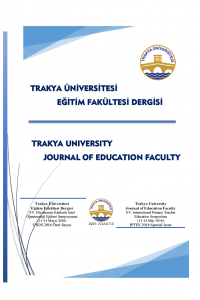Öz
Bu çalışmada, Mazer (2012)
tarafından geliştirilmiş olan Student Engagement Scale (Öğrenci Katılım Ölçeği,
ÖKÖ)’i Türkçeye uyarlamak, geçerlik ve güvenirlik analizlerini yapmak
amaçlanmıştır. Üniversite öğrencilerinin katılımını ölçmek için geliştirilen
ÖKÖ, 13 madde ve 4 boyuttan (sınıf içi sessiz davranışlar, sınıf içi sözlü
davranışlar, ders içeriği hakkında düşünme ve sınıf dışı davranışlar)
oluşmaktadır. İki ayrı çalışma yapılmıştır. Birinci çalışmada İngiliz Dili
Eğitimi Programı öğrencilerine (n= 25) ölçeğin İngilizce ve Türkçe formu 2
hafta ara ile verilmiştir. Katılımcıların iki forma verdikleri yanıtlar
arasında yüksek düzeyde ve pozitif yönde ilişki bulunmuştur (r= .80). İkinci
çalışmaya ise matematik ve sınıf öğretmenliği bölümlerinde okuyan 146 öğretmen
adayı katılmıştır. Doğrulayıcı faktör analizi sonuçları, önerilen modelin, veri
seti ile iyi uyum sağladığını göstermiştir. Ölçeğin alt boyutlarına ait
Cronbach Alpha güvenirlik katsayıları .70 ile .91 arasında değişmiştir. Analiz
sonuçları, ÖKÜ’nün geçerliliği ve güvenirliği hakkında delil sağlamıştır.
Anahtar Kelimeler
Kaynakça
- Baron, P. &Corbin, L. (2012). Student engagement: rhetoric and reality. Higher Education Research ve Development, 31(6), 759-772.
- Broeckelman-Post, M. A., Tacconelli, A., Guzmán, J., Rios, M., Calero, B. &Latif, F. (2016). Teacher Misbehavior and its Effects on Student Interest and Engagement. Communication Education, 65(2), 204-212.
- Fredricks, J. A., Blumenfeld, P. C. &Paris, A. H. (2004). School engagement: Potential of the concept, state of the evidence. Review of Educational Research, 74(1), 59-109.
- Harris, L. R. (2008). A phenomenographic investigation of teacher conceptions of student engagement in learning. The Australian Educational Researcher, 35(1), 57-79.
- Hu, L. T. &Bentler, P. M. (1999). Cutoff criteria for fit indexes in covariance structure analysis: Conventional criteria versus new alternatives. Structural equation modeling: a multidisciplinary journal, 6(1), 1-55.
- Jimerson, S. R., Campos, E. &Greif, J. L. (2003). Toward an understanding of definitions and measures of school engagement and related terms. The California School Psychologist, 8(1), 7-27.
- Jöreskog, K. G. &Sörbom, D. (1993). LISREL 8: Structural equation modeling with the Simplis command language. Lincolnwood: Scientific Software International, Inc.
- Kahu, E. R. (2013). Framing student engagement in higher education. Studies in Higher Education, 38(5), 758-773.
- Kelloway, E. K. (1998). Using LISREL for Structural Equation Modelin: A reseracher’s guide. Thousand Oaks, CA: Sage.
- Kuh, G. (2009). The national survey of student engagement: Conceptual and empirical foundations. New Directions for Institutional Research, 141, 5–20.
- Leach, L. (2016). Enhancing student engagement in one institution. Journal of Further and Higher Education, 40(1), 23-47.
- Lee, J. S. (2014). The Relationship Between Student Engagement and Academic Performance: Is It a Myth or Reality?. The Journal of Educational Research, 107(3), 177-185.
- Mazer, J. P. (2012). Development and validation of the student interest and engagement scales. Communication Methods and Measures, 6(2), 99-125, DOI: 10.1080/19312458.2012.679244.
- Meydan, C. H. & Şeşen, H. (2011). Yapısal eşitlik modellemesi AMOS uygulamaları. Ankara: Detay Yayıncılık.
- Meyer, D. K. &Turner, J. C. (2006). Re-conceptualizing emotion and motivation to learn in classroom contexts. Educational Psychology Review,18(4), 377-390.
- Noland, A. &Richards, K. (2015). Servant Teaching: An exploration of teacher servant leadership on student outcomes. Journal of the Scholarship of Teaching and Learning, 15(6), 16-38.
- Olwage, D. &Mostert, K. (2014). Predictors of student burnout and engagement among university students. Journal of Psychology in Africa, 24(4), 342-350. Parsons, J. &Taylor, L. (2011). Student Engagement: What Do We Know and what Should We Do?. University of Alberta.
- Reeve, J. & Tseng, C. M. (2011). Agency as a fourth aspect of students’ engagement during learning activities. Contemporary Educational Psychology, 36(4), 257-267.
- Reeve, J. &Lee, W. (2014). Students’ classroom engagement produces longitudinal changes in classroom motivation. Journal of Educational Psychology, 106(2), 527-540.
- Schumacker, R. E. &Lomax, R. G. (2004). A beginner's guide to structural equation modeling. Psychology Press. https://books.google.com.tr/books adresinden 05.05.2016 tarihinde alınmıştır.
- Seçer, İ. (2014). Ergenlerde obsesif kompulsif bozukluk ile anksiyete duyarlılığı arasındaki ilişkinin yapısal eşitlik modeli ile incelenmesi. Eğitim ve Bilim, 39(176), 369-382.
- Skinner, E. A., Kindermann, T. A. &Furrer, C. J. (2008). A motivational perspective on engagement and disaffection: Conceptualization and assessment of children’s behavioral and emotional participation in academic activities in the classroom. Educational and Psychological Measurement. 69(3), 493–525. DOI:10.1177/0013164408323233.
- Steele, G. A. (2015). New postgraduate student experience and engagement in human communication studies. Journal of Further and Higher Education, 39(4), 498-533.
- Steiger, J.H. (2007). Understanding the limitations of global fit assessment in structual equation modeling .Personality and Individual Differences, 42(5), 893-898.
- Tabachnick, B. G., Fidell, L. S. (2001). Using multivariate statistics. (Fourth Edition). MA: Allyn & Bacon, Inc.
- Turner, J. C., Christensen, A., Kackar-Cam, H. Z., Trucano, M. &Fulmer, S. M. (2014). Enhancing Students’ Engagement Report of a 3-Year Intervention With Middle School Teachers. American Educational Research Journal, 51(6), 1195–1226.
- Willms, J. D., Friesen, S. & Milton, P. (2009). What did you do in school today? Transforming classrooms through social, academic and intellectual engagement. (First National Report) Toronto: Canadian Education Association.
- Yin, H. &Wang, W. (2015). Undergraduate students’ motivation and engagement in China: an exploratory study. Assessment ve Evaluation in Higher Education, 41(4), 601-621, DOI: 10.1080/02602938.2015.1037240.
Ayrıntılar
| Bölüm | Makaleler |
|---|---|
| Yazarlar | |
| Yayımlanma Tarihi | 5 Ocak 2018 |
| Yayımlandığı Sayı | Yıl 2018 Cilt: 8 Sayı: 1 |


